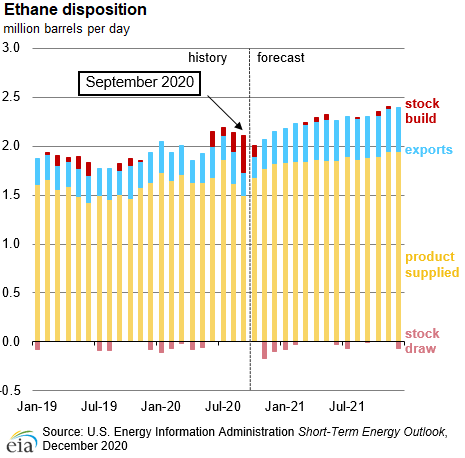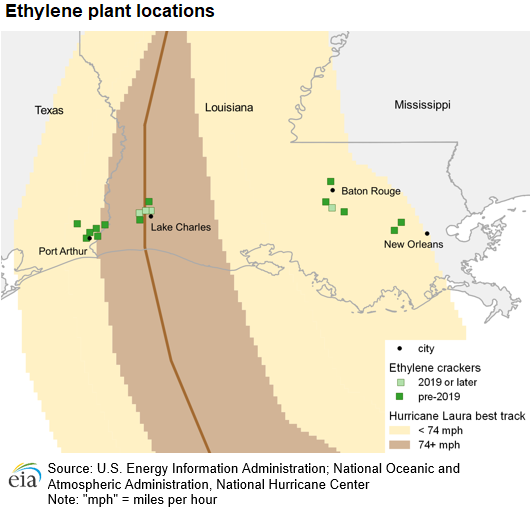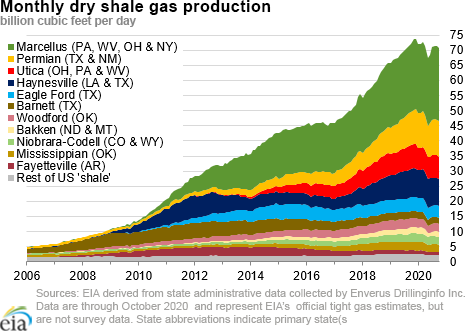In the News:
Hurricane Laura led to less ethane consumption and a record stock build in September
According to the U.S. Energy Information Administration’s (EIA) November Petroleum Supply Monthly, implied ethane consumption for September, reported as product supplied, fell by 7.8% to 1.49 million barrels per day (b/d). On August 27, Hurricane Laura made landfall just south of Lake Charles, Louisiana, which affected operations at ethylene crackers in the region and resulted in reduced average September ethane demand by an estimated 240,000 b/d. Hurricane-force winds and the storm surge accompanying the hurricane’s arrival on the Louisiana coast affected several ethylene crackers in the immediate Lake Charles area and marine operations as far away as the Houston Ship Channel, where the Morgan’s Point ethane export terminal is located.
Ethane, which is recovered from raw natural gas at natural gas processing plants, is used as a petrochemical feedstock in steam crackers that convert ethane into ethylene—the precursor for widely used plastics and resins. Petrochemical sites, including three newly completed ethylene crackers, were directly affected by damage and debris from Hurricane Laura; however, power loss affected petrochemical plants beyond the Lake Charles region and caused shutdowns of ethylene crackers, some of which lasted more than a month. The hurricane-related disruption to ethane-consuming activity followed a period of rapid industry expansion, particularly in Louisiana, where four new ethylene crackers (nearly 200,000 b/d of ethane capacity additions) have come online in the past 12 months. Before Hurricane Laura developed into a Category 4 storm and made landfall, our August Short-Term Energy Outlook (STEO) forecast September U.S. ethane disposition (domestic consumption plus exports), based on these capacity additions, to reach 2.05 million b/d—levels matching record highs in January, prior to COVID-driven demand declines.
Although ethane demand decreased and ethane prices declined during September, they remained at a premium to natural gas because of continued market expectations of consumption growth and an anticipated increase in ethane exports at the end of the year. When ethane is priced at a premium to natural gas, natural gas processing plant operators have more incentive to recover ethane and sell it into the liquids market rather than leave it in the natural gas stream to be sold for its heat value to natural gas consumers—a process known as ethane rejection. Through September, ethane spot prices at Mont Belvieu, Texas (the main U.S. hydrocarbon gas liquids (HGL) hub), averaged $2.99 per million British thermal units (MMBtu)—a premium of $1.07/MMBtu over the natural gas spot price at Henry Hub, which averaged $1.92/MMBtu.
Elevated production spurred by its price premium to natural gas, alongside lower demand due to hurricane-related plant outages, resulted in a September ethane stock build of 11.3 million barrels, or 376,000 b/d, the fastest pace since 2010, when EIA’s ethane-only inventory data series begins. End-of-September ethane inventories reached 72.2 million barrels, also the highest on record. The December STEO forecasts more inventory builds in October, followed by rapid inventory draws through the end of 2020. In addition, ethylene cracking activity is expected to rebound, and exports are expected to grow once the 180,000 b/d Orbit export terminal is completed in Nederland, Texas.
Overview:
(For the week ending Wednesday, December 9, 2020)
- Natural gas spot prices fell at most locations this report week (Wednesday, December 2 to Wednesday, December 9). The Henry Hub spot price fell from $2.70 per million British thermal units (MMBtu) last Wednesday to $2.45/MMBtu yesterday.
- At the New York Mercantile Exchange (Nymex), the price of the January 2021 contract decreased 34¢, from $2.780/MMBtu last Wednesday to $2.442/MMBtu yesterday. The price of the 12-month strip averaging January 2021 through December 2021 futures contracts declined 20¢/MMBtu to $2.576/MMBtu.
- The net withdrawals from working gas totaled 91 billion cubic feet (Bcf) for the week ending December 4. Working natural gas stocks totaled 3,848 Bcf, which is 9% more than the year-ago level and 7% more than the five-year (2015–19) average for this week.
- The natural gas plant liquids composite price at Mont Belvieu, Texas, fell by 5¢/MMBtu, averaging $5.39/MMBtu for the week ending December 9. The prices of ethane, isobutane, and butane fell by 6%, 7%, and 9%, respectively. The prices of natural gasoline and propane rose by 4% and 5%, respectively.
- According to Baker Hughes, for the week ending Tuesday, December 1, the natural gas rig count decreased by 2 to 75. The number of oil-directed rigs rose by 5 to 246. The total rig count increased by 3, and it now stands at 323.
Prices/Supply/Demand:
Prices fall at most locations across the Lower 48 states. This report week (Wednesday, December 2 to Wednesday, December 9), the Henry Hub spot price fell 25¢ from a high of $2.70/MMBtu last Wednesday to $2.45/MMBtu yesterday. Temperatures were generally warmer than normal across most of the Lower 48 states and much warmer than normal across the Great Plains. Temperatures were cooler than normal along most of the eastern seaboard. At the Chicago Citygate, the price decreased 35¢ from a high of $2.62/MMBtu last Wednesday to $2.27/MMBtu yesterday.
California prices are down. The price at PG&E Citygate in Northern California fell 26¢, down from a high of $3.71/MMBtu last Wednesday to $3.45/MMBtu yesterday. The price at SoCal Citygate in Southern California decreased 9¢ from $4.83/MMBtu last Wednesday to $4.74/MMBtu yesterday. Maintenance along the El Paso Natural Gas pipeline has limited natural gas flows from the Permian Basin to Southern California, putting upward pressure on prices.
Northeast prices fall in New York, but are up in New England amid a Nor’easter. At the Transcontinental Pipeline Zone 6 trading point for New York City, the price decreased 10¢ from $2.45/MMBtu last Wednesday to $2.35/MMBtu yesterday, after reaching a high of $2.56/MMBtu on Friday. At the Algonquin Citygate, which serves Boston-area consumers, the price went up 29¢ from $2.41/MMBtu last Wednesday to $2.70/MMBtu yesterday. Prices reached a high of $3.08/MMBtu on Friday in advance of a Nor’easter that brought snow to the region over the weekend. Customers lost power in Massachusetts, New Hampshire, and Maine. Maine’s local utility, Central Maine Power (CMP), reported the highest number of customers without power; approximately 231,000 customers lost power on Sunday. As of yesterday, CMP reported that power had been restored to nearly all customers.
The Tennessee Zone 4 Marcellus spot price decreased 7¢ from $1.92/MMBtu last Wednesday to $1.85/MMBtu yesterday. The price at Dominion South in southwest Pennsylvania fell 8¢ from $1.94/MMBtu last Wednesday to $1.86/MMBtu yesterday.
Permian Basin price differential to the Henry Hub widens. The price at the Waha Hub in West Texas, which is located near Permian Basin production activities, averaged a high of $2.62/MMBtu last Wednesday, 8¢/MMBtu lower than the Henry Hub price. Yesterday, the price at the Waha Hub averaged $2.25/MMBtu, 20¢/MMBtu lower than the Henry Hub price.
Supply rises slightly, driven by increase in imports from Canada. According to data from IHS Markit, the average total supply of natural gas rose by 0.1% compared with the previous report week. Dry natural gas production decreased by 1.2% compared with the previous report week. Average net imports from Canada contributed an average of 5.8% of total supply this report week, following a week-over-week 24.1% increase. Imports to demand markets in the U.S. Great Plains increased because of low demand in Western Canada.
Total demand rises because of increased heating demand in residential and commercial buildings. Total U.S. consumption of natural gas rose by 11.5% compared with the previous report week, according to data from IHS Markit. Natural gas consumed for power generation climbed by 9.4% week over week. In the residential and commercial sectors, consumption increased by 20.7% as a result of low average U.S. temperatures of between 35 degrees to 45 degrees Fahrenheit. Industrial sector consumption increased by 2.1% week over week. Natural gas exports to Mexico decreased 1.7%. Natural gas deliveries to U.S. liquefied natural gas (LNG) export facilities (LNG pipeline receipts) averaged 11.2 Bcf/d, or 0.89 Bcf/d higher than last week.
U.S. LNG exports increase week over week. Twenty-two LNG vessels (eight from Sabine Pass, five each from Corpus Christi and Freeport, two from Cameron, and one each from Cove Point and Elba Island) with a combined LNG-carrying capacity of 81 Bcf departed the United States between December 3 and December 9, 2020, according to shipping data provided by Bloomberg Finance, L.P.
Corpus Christi LNG terminal in Texas shipped first commissioning cargo from its third liquefaction unit (Train 3) last week. Corpus Christi is a three-train LNG export facility with a combined export capacity of 1.8 Bcf/d baseload (2.0 Bcf/d peak), located in San Patricio County, Texas. Train 3 came online six months ahead of the initially announced in-service date of May 2021.
Currently, the United States has 15 standard-size LNG trains and 10 small-scale Moveable Modular Liquefaction System (MMLS) units in operation across six LNG export facilities with a combined LNG export capacity of 9.5 Bcf/d baseload (10.8 Bcf/d peak).
Storage:
The net withdrawals from storage totaled 91 Bcf for the week ending December 4, compared with the five-year (2015–19) average net withdrawals of 61 Bcf and last year's net withdrawals of 57 Bcf during the same week. Working natural gas stocks totaled 3,848 Bcf, which is 260 Bcf more than the five-year average and 309 Bcf more than last year at this time.
According to The Desk survey of natural gas analysts, estimates of the weekly net change to working natural gas stocks ranged from net withdrawals of 70 Bcf to 99 Bcf, with a median estimate of 83 Bcf.
More storage data and analysis can be found on the Natural Gas Storage Dashboard and the Weekly Natural Gas Storage Report.
See also:
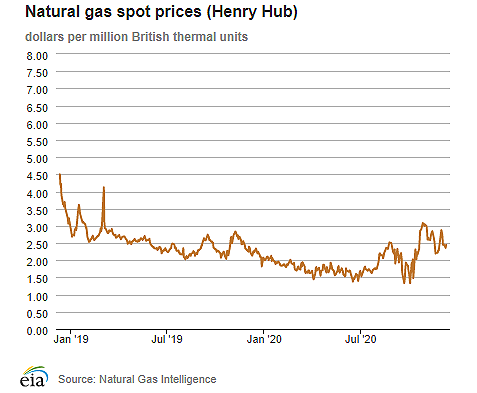
| Spot Prices ($/MMBtu) | Thu, 03-Dec |
Fri, 04-Dec |
Mon, 07-Dec |
Tue, 08-Dec |
Wed, 09-Dec |
|---|---|---|---|---|---|
| Henry Hub |
2.45 |
2.47 |
2.41 |
2.36 |
2.45 |
| New York |
1.86 |
2.56 |
2.37 |
2.37 |
2.35 |
| Chicago |
2.30 |
2.35 |
2.20 |
2.22 |
2.27 |
| Cal. Comp. Avg.* |
3.56 |
3.30 |
3.20 |
3.22 |
3.35 |
| Futures ($/MMBtu) | |||||
| January contract | 2.507 |
2.575 |
2.406 |
2.399 |
2.442 |
| February contract |
2.515 |
2.586 |
2.433 |
2.422 |
2.456 |
| *Avg. of NGI's reported prices for: Malin, PG&E Citygate, and Southern California Border Avg. | |||||
| Source: NGI's Daily Gas Price Index | |||||
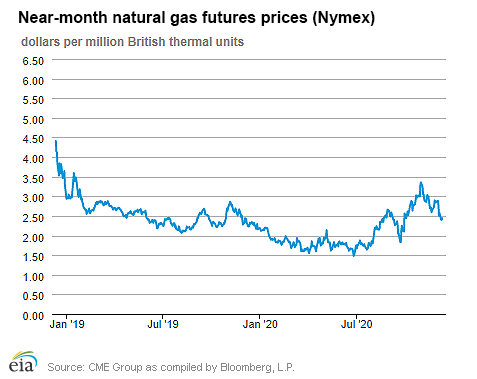
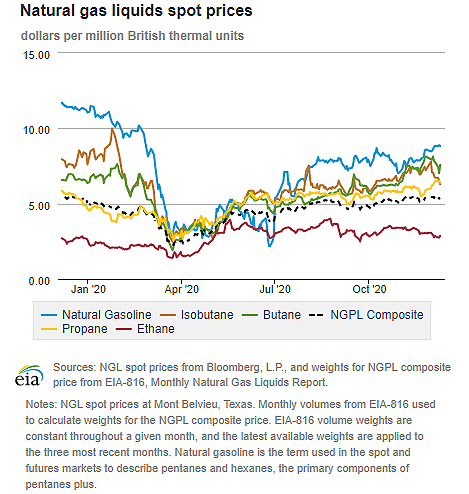
| U.S. natural gas supply - Gas Week: (12/3/20 - 12/9/20) | |||
|---|---|---|---|
Average daily values (Bcf/d): |
|||
this week |
last week |
last year |
|
| Marketed production | 101.1 |
102.5 |
107.6 |
| Dry production | 89.9 |
91.0 |
96.6 |
| Net Canada imports | 5.7 |
4.6 |
4.2 |
| LNG pipeline deliveries | 0.2 |
0.1 |
0.2 |
| Total supply | 95.8 |
95.8 |
100.9 |
|
Source: IHS Markit | |||
| U.S. natural gas consumption - Gas Week: (12/3/20 - 12/9/20) | |||
|---|---|---|---|
Average daily values (Bcf/d): |
|||
this week |
last week |
last year |
|
| U.S. consumption | 89.2 |
80.0 |
88.2 |
| Power | 28.2 |
25.7 |
27.8 |
| Industrial | 24.3 |
23.8 |
23.7 |
| Residential/commercial | 36.8 |
30.5 |
36.7 |
| Mexico exports | 5.6 |
5.7 |
5.1 |
| Pipeline fuel use/losses | 7.4 |
7.2 |
7.8 |
| LNG pipeline receipts | 11.2 |
10.3 |
7.7 |
| Total demand | 113.4 |
103.2 |
108.8 |
|
Source: IHS Markit | |||
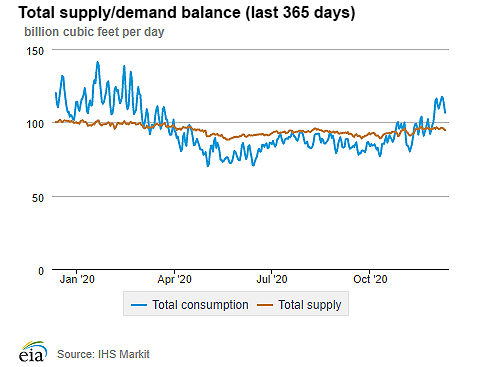
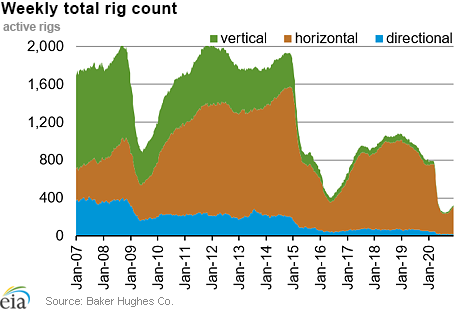
| Rigs | |||
|---|---|---|---|
Tue, December 01, 2020 |
Change from |
||
last week |
last year |
||
| Oil rigs | 246 |
2.1% |
-62.9% |
| Natural gas rigs | 75 |
-2.6% |
-43.6% |
| Note: Excludes any miscellaneous rigs | |||
| Rig numbers by type | |||
|---|---|---|---|
Tue, December 01, 2020 |
Change from |
||
last week |
last year |
||
| Vertical | 16 |
6.7% |
-69.2% |
| Horizontal | 289 |
2.1% |
-58.4% |
| Directional | 18 |
-18.2% |
-65.4% |
| Source: Baker Hughes Co. | |||
| Working gas in underground storage | ||||
|---|---|---|---|---|
Stocks billion cubic feet (Bcf) |
||||
| Region | 2020-12-04 |
2020-11-27 |
change |
|
| East | 915 |
934 |
-19 |
|
| Midwest | 1,095 |
1,122 |
-27 |
|
| Mountain | 232 |
240 |
-8 |
|
| Pacific | 312 |
318 |
-6 |
|
| South Central | 1,294 |
1,326 |
-32 |
|
| Total | 3,848 |
3,939 |
-91 |
|
|
Source: Form EIA-912, Weekly Underground Natural Gas Storage Report | ||||
| Working gas in underground storage | |||||
|---|---|---|---|---|---|
Historical comparisons |
|||||
Year ago (12/4/19) |
5-year average (2015-2019) |
||||
| Region | Stocks (Bcf) |
% change |
Stocks (Bcf) |
% change |
|
| East | 874 |
4.7 |
855 |
7.0 |
|
| Midwest | 1,021 |
7.2 |
1,030 |
6.3 |
|
| Mountain | 195 |
19.0 |
206 |
12.6 |
|
| Pacific | 279 |
11.8 |
303 |
3.0 |
|
| South Central | 1,170 |
10.6 |
1,194 |
8.4 |
|
| Total | 3,539 |
8.7 |
3,588 |
7.2 |
|
| Source: Form EIA-912, Weekly Underground Natural Gas Storage Report | |||||
| Temperature – heating & cooling degree days (week ending Dec 03) | ||||||||
|---|---|---|---|---|---|---|---|---|
HDD deviation from: |
CDD deviation from: |
|||||||
| Region | HDD Current |
normal |
last year |
CDD Current |
normal |
last year |
||
| New England | 145 |
-54 |
-87 |
0 |
0 |
0 |
||
| Middle Atlantic | 147 |
-42 |
-66 |
0 |
0 |
0 |
||
| E N Central | 204 |
-14 |
-3 |
0 |
0 |
0 |
||
| W N Central | 222 |
-21 |
-3 |
0 |
0 |
0 |
||
| South Atlantic | 118 |
-13 |
-8 |
9 |
-1 |
1 |
||
| E S Central | 155 |
20 |
26 |
0 |
-1 |
0 |
||
| W S Central | 113 |
15 |
34 |
2 |
-2 |
-5 |
||
| Mountain | 215 |
8 |
3 |
0 |
0 |
0 |
||
| Pacific | 92 |
-15 |
-44 |
0 |
-1 |
0 |
||
| United States | 157 |
-14 |
-17 |
2 |
0 |
0 |
||
|
Note: HDD = heating degree day; CDD = cooling degree day Source: National Oceanic and Atmospheric Administration | ||||||||
Average temperature (°F)
7-day mean ending Dec 03, 2020
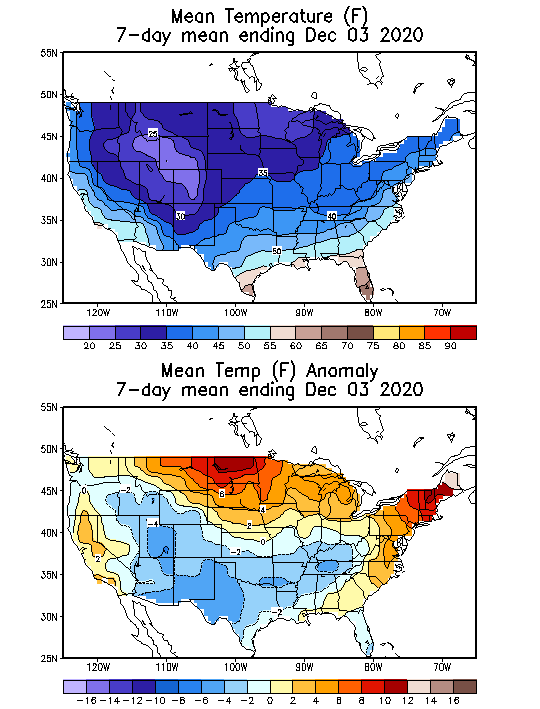
Source: National Oceanic and Atmospheric Administration
Deviation between average and normal (°F)
7-day mean ending Dec 03, 2020

Source: National Oceanic and Atmospheric Administration

